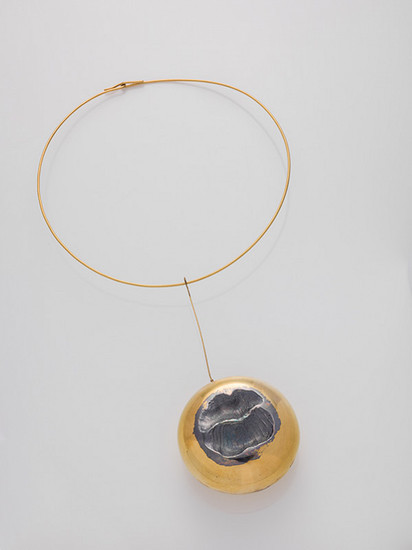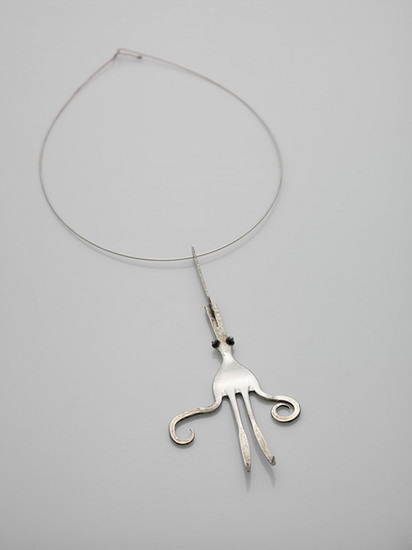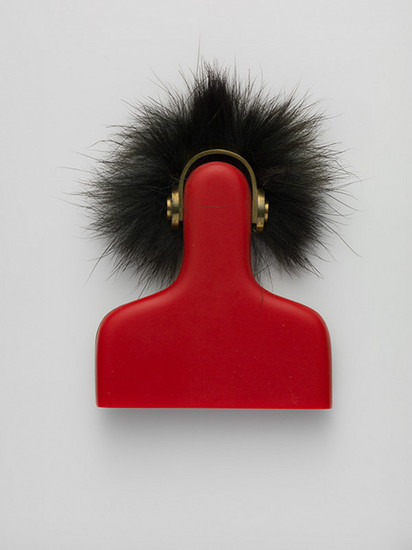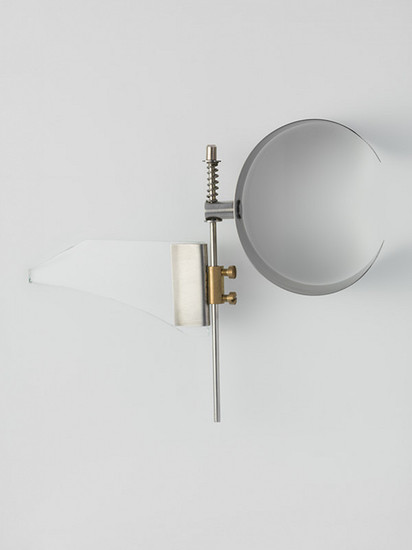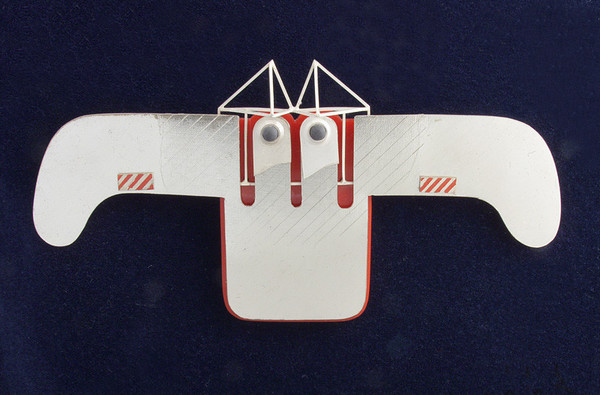The SNG's collection of studio jewellery is Slovakia's only systematically and consistently pursued public grouping of this relatively young artistic discipline. Central Europe has similar collections of 20th- and 21st-century studio/art jewellery, for instance in Brno's Moravian Gallery, Prague's Museum of Decorative Arts and Vienna's MAK. The largest and highest-quality museum collection of studio jewellery in Europe (with remarkable international representation) belongs to Die Neue Sammlung - The Design Museum in Munich, which also exhibits it in a long-term exposition (where Slovakia is represented in work by Anton Cepka).
Jewellery that has no identity as personal adornment - a work of art distinctive in its scale, its relationship to the human body and its ability to communicate - became a target of purposeful artistic interest in the 1960s. This was when a number of artists began designing jewellery primarily for its value as art, and without a direct commercial market. For them, jewellery then went beyond a narrowly specialized craft; further, they consciously distanced themselves from those who understood it as a status symbol, fashion decoration or luxury merchandise. This new jewellery opened and blazed fresh trails that cut across genres of art, with an enthusiastic practicing of "heresy" in terms of material, visual effect, content and societal norms, with the aim of redefining itself as a full-fledged and noteworthy part of the contemporary reforms in visual arts.
The SNG's interest in collecting also dates to the 60s, initiated in the latter half of the decade by the lone but compelling work of Anton Cepka. Today there are almost 500 pieces in the studio jewellery collection of the SNG, part of its Collections of Architecture, Applied Arts and Design. Jewellery by artists in Slovakia, evolving from its 1960s origins to the millennium's end, makes up most of it. As of now there is scant representation of the period since 2000; thus it seems an urgent task in the future will be to capture work by the vital and in many ways remarkable middle- and younger-generation jewellers in the SNG collection. The collection initially took on an international aspect in the late 1970s through sporadic purchases from SNG exhibits, then in the 1990s by way of intensive acquisitions at international art jewellery symposia in Kremnica. In this way, work by the renowned Dutch jewellers Gijs Bakker and Annelies Planteydt came into the collection. Close ties to Czech jewellery, which up to 1990 was in large part due to the possibility of Slovak students attending tertiary education in jewellery-making, is recognized in the collection by pieces from numerous Czech individuals, including such respected artists as Josef Symon, Alena Nováková, Vratislav Karel Novák, Jaroslav Kodejš, Pavel Opočenský and Svatopluk Kasalý.
The origins of the SNG's studio jewellery collection date to 1966, when the procurements of the 6th commission for the applied and industrial arts included four pieces by Anton Cepka. Two of them were part of his thesis work at the Academy of Arts, Architecture and Design in Prague, which rocketed him to recognition in throughout the European art jewellery community - at the prestigious Munich International Handicraft Fair, this collection won him a Bavarian State Prize. Since then the SNG has regularly pursued acquiring Cepka's work, resulting in nearly 50 of his pieces ranging from studio and design jewellery, through objects and architectural realizations, to drawings. This is the most extensive collection of pieces by this exceptionally esteemed artist, represented in major institutional and private collections in Europe, the USA, and Australia. Cepka was Slovakia's first professionally trained jeweller; domestic studio jewellery began to come together little by little through the 1960s, thanks to the fact that sculptors, artisans and other graduates of the specialization at Prague's Academy of Arts, Architecture & Design (AAAD) took it up.
The first exhibition of studio jewellery by those in Slovakia, Contemporary Slovak Jewellery, presented at the SNG in 1976 by Ágnes Schrammová, was a promising introduction of the new artistic discipline. Her work turned the focus on studio jewellery into a strategy, essential and long-term in nature, for the Collection of Applied and Industrial Art. The presentation, which captured the work of dozens of artists working in Slovakia, was drawn in large part from the SNG collection. Besides the fundamental works of Anton Cepka, it included jewellery done by Václav Cigler; sculpture-motif jewellery from Erna Masarovičová, Alina Ferdinandy,Jozef Jankovič and Dušan Králik; Remígia Biskupská's innovated version of traditional wire tinkering; material and technique experiments by Jana Cepková (in enamel) and Peter Mišík (in hard filigree); and the constructive jewellery of Imrich Svitana, who like Anton Cepka and Jana Cepková studied artistic metalwork at the AAAD in Prague.From this time, the collection began including the specific category of glass jewellery, so characteristic of Czech studio jewellery. In addition to Václav Cigler pieces there are others by Václav Plátek, and since the late 1970s the collection expanded to include work by graduates of Cigler's Glass in Architecture Studio at the Academy of Fine Arts and Design in Bratislava (Jozef Vachálek, Pavol Hlôška, Milan Gašpar, Eva Potfajová, Pavel Tomečko, Jozef Tomečko, Askold Žáčko and more). Another teacher after Cigler who carried on cultivating the line of glass jewellery in his students was Askold Žáčko (head of the studio from 1979 to 1990). These studios also produced some jewellery not tied to glass work; moving between materials, techniques, and cross-border artistic perspective, which had long characterized Cigler's studio, resulted in numerous interesting jewellery experiments. Some of these were successfully added to the SNG collection (such as work by Miloš Balgavý jr, Juraj Opršal, and Anna Daučíková). Also represented is jewellery by the expressive personalities in glass, Ľubomír Blecha and Ľubomír Arzt, as well as several examples of glass jewellery in its peak phase by the Czech jewellers Vratislav Karel Novák, Svatopluk Kasalý, Jaroslav Kodejš, and others.
Artists specializing in jewellery (graduates of Prague's Academy of Arts, Architecture and Design, and those of secondary schools in Kremnica and in Turnov in the Czech Republic) helped studio jewellery in Slovakia slowly mature, but it was no less influenced by artists who approached jewellery themes from other visual art genres (both in short-term departures and longer commitments). Thus from the mid-1980s, what had mainly been limited to those with interest in sculpture and glass art was joined by textile and ceramics artists, architects, painters... This medium is by no means an exclusive club, but rather is an open and fluid arena, with an affinity for current post-modern trends. This vein, strong within the SNG collection, appears in jewellery objects by the multidisciplinary experimenter Karol Pichler, and the "destructive construction" in armoury-likejewellery by Aleš Votava, as well as in Silvia Fedorová's fine textile lacework interacting with the body, and Imrich Vanek's heavy porcelain knots in necklaces. Since the late 80s, the painter Daniel Brunovský has brought the eminence of gold (along with the aura of the goldsmith's history) back into studio jewellery. Karol Weisslechner, originally an architect, understands jewellery as a provocative and urgent entropy of the body, and makes bold to incorporate impermanent and organic materials (such as plaster and hair). As he has taken an eminent professional interest in jewellery since the early 1990s, it was ultimately he that took over the training of jewellers Anton Cepka in 1995 at Bratislava's Academy of Fine Arts and Design.
The collection of studio jewellery grew modestly but steadily over the years, with a unique purchase in 1991, when the collection grew by some 100 additions. This significant acquisition arose from the large dedicated exhibition held at the SNG as a survey of jewellery work in Slovakia from 1961 to 1991. Similarly there were a number of pieces by artists from Slovakia and abroad through the recently-established International Art Jewellery Symposium in Kremnica, and the SNG's exhibition Contemporary Dutch Jewellery.
Contemporary studio jewellery in the SNG collection is principally represented by the work of Bratislava's Academy of Art and Design Studio S+M+L_XL - Metal and Jewel - Jana Machatová, Sylvia Jokelová and Betty K. Majerníková.
